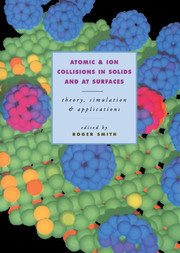5 - Transport models
Published online by Cambridge University Press: 13 October 2009
Summary
The Boltzmann transport equation
Introduction
Atomic particles are both deflected and slowed down after scattering by a target atom. This process is fundamental to the study of the penetration of ions in solid targets. A typical ion–solid experiment would involve many ion trajectories comprising several scatterings. Computer models tackle the problem head-on by calculating entire collision cascades from a representative set of trajectories. These results can then be used to evaluate average values such as the mean penetration depth and the mean number of particles ejected within a certain angle or energy range. However, the computer models often contain details that are not accessible to experimental observation and vast amounts of computing time can often be expended in generating these average results.
Computational techniques are discussed in more detail elsewhere in this book. In this chapter a probabilistic description amenable to analytic methods is described.
The mathematical means to tackle problems such as those in ion–solid interactions were introduced in the last century, in the context of kinetic theory. This theory allows the determination of macroscopic properties of matter from a knowledge of the elementary atomic interactions. One of the most outstanding results of this theory is the Boltzmann transport equation and we will discuss in this chapter the derivation of the equation and how it may be used to solve a variety of problems concerning the penetration of ions in solids.
In this section the Boltzmann transport equation in the so-called forward form is derived.
- Type
- Chapter
- Information
- Atomic and Ion Collisions in Solids and at SurfacesTheory, Simulation and Applications, pp. 99 - 160Publisher: Cambridge University PressPrint publication year: 1997

